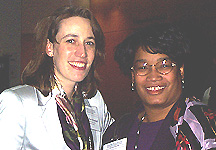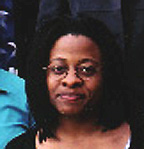
| T H E N I H C A T A L Y S T | J A N U A R Y – F E B R U A R Y 2001 |
|
|
|
NIAMS Conference SCRATCHING
THE SURFACE OF DISPARITIES:
|
|
 |
|
Susan
Taylor
|
Multilayered Truths
Beauty is not the only thing that is skin deep.
Speaking at a NIAMS-sponsored meeting here in December, Susan Taylor, director of The Skin of Color Center, at New York’s St. Luke’s-Roosevelt Hospital Center, addressed the lack of research in dermatological conditions in persons of color. Experimental bias based on race, she said, has left large gaps in dermatologic diagnosis and treatment among nonwhite populations. For instance, it is not clear why whites account for nearly 90 percent of office visits for common acne and for prescriptions filled for isoretinoin (Accutane), which has been found to be effective against acne regardless of skin color. Cultural habits of patients, lower rates of acne in blacks, and physician education could each play a role in these numbers, she observed, but there is a lack of sound scientific evidence to support an assumption that racial differences exist in the structure, function, and biology of skin and hair.
 |
|
Alexa
Kimball (left) |
Closing such knowledge gaps underlies recent proposed and actual modifications of NHANES (National Health and Nutrition Examination Survey) protocols, according to Natalie Dupree, a NHANES researcher and Alexa Boer Kimball, a professor of dermatology and director of the Clinical Trials Unit at Stanford (Calif.) University Medical Center. Not only is NHANES now oversampling subgroup populations such as African-Americans and Hispanics but it is also studying the feasibility of including digital imaging of skin conditions to build up dermatologic databases and gather information in a statistically significant manner.
Conversely, African-Americans account for 90 percent of patients with keloids, a condition characterized by overproduction of dermal collagen during healing of a piercing wound, most commonly ear piercing. Sixty percent of patients have at least one close relative with keloids. Despite these statistics, the study of keloids is hampered by the usual stumbling blocks: a dearth of epidemiological data that would facilitate directed research at the cellular and genetic levels, according to A. Paul Kelly, chief of dermatology at the King-Drew Medical Center in Los Angeles.
Lupus Erythematosus
Despite the fact that the incidence of systemic lupus erythematosus (SLE) is three to four times as high in African-American women as in white women, there is no firm understanding of what role, if any, race plays in its pathogenesis. Researchers presented an array of potential causes of SLE, underscoring the need for subgroup analysis.
 |
|
Patricia
Fraser
|
Jane Salmon, professor of medicine at New York’s Weill Medical College of Cornell/University Hospital for Special Surgery, looked at genetic variations in receptors for an immunoglobulin (Fc-R) and found that certain low-binding alleles of Fc-R were enriched in Hispanic and African-American patients with SLE. Genetic factors, she observed, may in part account for variation in SLE prevalence, clinical manifestation, course, and outcome among ethnic groups.
Patricia Fraser, of Harvard Medical School and Brigham and Women’s Hospital, Boston, emphasized that behavioral, genetic, and environmental factors most likely combine to produce increased SLE risk. She pointed out that the risk for lupus is two to three times as high among smokers and/or those exposed to smoking in childhood. She also examined populations in four counties near Boston and found links between SLE incidence and environmental factors, such as living near petrochemicals and hazardous waste sites. Glinda Cooper and her group at NIEHS found that breast feeding, which she noted is less common among African-American women, appears to confer some protection against SLE. The Environmental Diseases Study Group of the American College of Rheumatology documented ties between lupus and certain medications, heavy metals, chemicals, and other compounds. Elizabeth Karlson, of Harvard Medical School, reported links between socioeconomic status and SLE morbidity and mortality, regardless of race. Overall, speakers agreed that understanding environmental determinants could help identify potentially modifiable psychosocial, behavioral, or clinical risks and possibly preclude induction of the disease in susceptible populations, regardless of ethnicity. Similarly, insight into the genetic basis of disease can offer clues to pathogenesis, provide predictors of disease severity, and perhaps suggest a means to develop possible cures.
Pain and Bias
Equal access to health care does not necessarily result in equal treatment or outcome.
In the session with the most heated discussions, speakers elaborated on the ways physician bias related to sex and ethnicity and patient mistrust can undermine disease management in such areas as osteoarthritis, joint replacement, and pain.
Tim Carey, director of the Cecil Sheps Center for Health Services Research at the University of North Carolina, Chapel Hill, presented findings from studies undertaken with his colleague Joanne Garrett demonstrating a disconnect between patient status and physician interpretation. They found that lower back pain in blacks was accompanied by higher pain scores and functional disability than in whites, but that practitioners believed that blacks actually experienced less severe pain than their white counterparts. These practitioners were less likely to consider disc disease or neurological treatment in their black patients. Radiographic and imaging studies were less frequently offered black patients, regardless of income, education, and insurance. Blacks were also less likely to be hospitalized or have surgery—despite similar care-seeking behavior—and over time had worsened functional status.
 |
|
Christopher
Edwards
|
Additionally, according to Christopher Edwards, director of the Chronic Pain Management Program at Duke University Medical Center in Durham, N.C., Medline and other searches in the area of pain retrieved only 49 articles among some 53,000 that contained references to black cohorts, most since 1996.
Patient preferences also contribute to treatment disparities among white and minority populations. Dissatisfaction with conventional treatment, mistrust of the system, more faith in alternative approaches, and more self-reliance have been found to inform the health-care decisions of members of minority groups. Augustine Escalante, of the University of Texas Health Science Center at San Antonio, pointed out that Hispanics have been found to underutilize hip replacement, compared with whites, independent of access to health care or insurance.
Kent Kwoh, director of clinical research in the Division of Rheumatology and Clinical Immunology at the University of Pittsburgh School of Medicine, found that minorities are half as likely to opt for joint replacement and more likely to use over-the-counter oils and lotions, copper bracelets, chiropractic, and prayer. And in a study of veterans with equal insurance and available counseling, African-Americans were found to expect more pain and less benefit from joint replacement than their white counterparts. Edwards suggested that some of these racial disparities might be explained by "John Henryism," a coping strategy among blacks based on the perception that "illness can be dealt with by hard work and confidence, rather than care seeking." Lawren Daltroy, associate director of the Robert B. Brigham Multipurpose Arthritis and Musculoskeletal Diseases Center at Brigham & Women’s Hospital, pointed out that "in the absence of education, both African Americans and Hispanics have more nihilistic beliefs (about arthritis treatment)."
 |
|
Nicole
Brown
|
Learning Curve
The effect of education, outreach, and social support on patient health, pain management, care seeking, and treatment selection were attested to by individuals from health-education projects around the country, including the Los Angeles County Rheumatoid Arthritis Health Project, the Spanish Arthritis Self-Help Program (developed by Kate Lorig, director of the Stanford Patient Education Research Center, Stanford University School of Medicine), the New York State Osteoporosis Prevention through Education Program, and the Michigan Arthritis Foundation’s Arthritis Awareness-Urban Outreach program.
Lorig urged NIAMS to devote attention to practitioner education, the health effect of socioeconomic status, and evidence-based clinical policy-making, as well as increased public education. She cited the NIH Academy (see "NIH Academy Up and Running") as a source of future investigators with the insight and training to reduce and ultimately eliminate health disparities.
Indeed, Academy students
were vocal and visible participants throughout the conference, and one, Nicole
Brown, challenged each of the panelists to "develop your own NIH Academy
program at your own institution." ![]()
| Co-sponsors of this December 15–16 meeting were the NIH Offices of Research on Minority Health, Research on Women's Health, Disease Prevention, and Behavioral and Social Sciences Research, as well as the Centers for Disease Control and Prevention, the Arthritis Foundation, the American College of Rheumatology, American Academy of Orthopaedic Surgeons, and American Academy of Dermatology. |
|
NIAMS Turns Policy into Practice The NIAMS rheumatology research program now extends from the Clinical Center on the NIH campus to three clinic sites in Washington, D.C., where medically underserved people, including those who are homeless, can receive treatment for rheumatic diseases and, if warranted, can enroll in NIAMS clinical trials. NIAMS’ partner in this venture is Unity Health Care, Inc., a Washington-based nonprofit organization with community leaders in the African-American and Hispanic-Latino communities that has established the sites at which NIAMS will run its model community-based rheumatology clinic. This is the first tangible product of the NIAMS Health Partnership Program, an institute initiative designed to gain more insight into the reasons for health disparities, to treat and prevent complications and chronic disabilities associated with rheumatic diseases, to provide medical care for disproportionately affected members of minority groups and increase their participation in clinical trials, and to increase the number of underrepresented minority researchers at NIAMS and elsewhere. Initially focused on arthritis, lupus, and other rheumatic diseases, the clinic will eventually treat patients with muscle, bone, and skin diseases as well. People can refer themselves or be referred by a physician from Unity Health Care or any other health-care organization. All care is free. The main clinic houses rooms for examinations, physical and occupational therapy, health education programs, and a demonstration kitchen. Two outreach facilities, one at a homeless shelter, are staffed to screen and refer patients to the main clinic; transportation is provided. There are three possible levels of care. The first level includes such services as physical and occupational therapy and recommendations regarding diet and exercise; initial screening is by nurse practitioners. If referral to a rheumatologist is needed, the second level of care comes into play and requires written informed consent. The patient would be enrolled in a natural history study and would receive standard medical care—including X-rays, blood tests, and other laboratory tests, which would be provided at the Clinical Center, along with transportation to and from NIH. The data amassed in this natural history study are expected to help explain the bases for health disparities. The third level of care would involve enrollment in clinical trials for patients whose condition warrants consideration for a particular experimental protocol; a separate consent form would be required in such cases. Participation at all levels is voluntary, and patient requests for information sharing with other health professionals will be honored. NIAMS expects to
have a formal open house in the spring. |